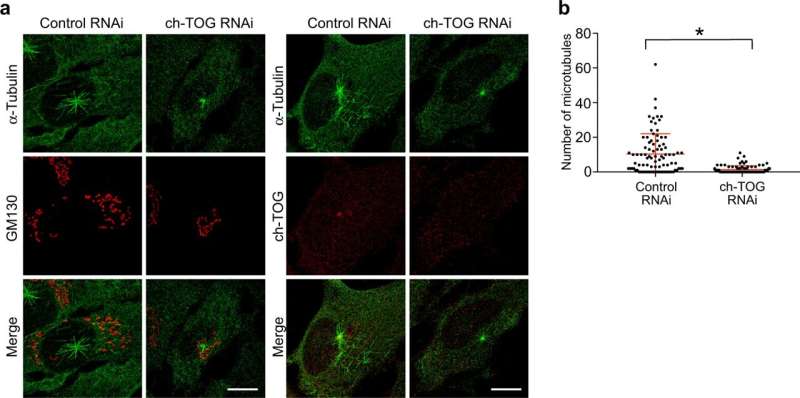ch-TOG promotes nucleation from the Golgi. a RPE1 control and ch-TOG RNAi cells were treated with nocodazole to depolymerize microtubules. After washout and incubation in ice, microtubules were allowed to regrow for 10 s. Cells were fixed and stained with antibodies against GM130 (Golgi), α-tubulin (microtubules), and ch-TOG. Scale bar, 10 µm. b The number of microtubules growing from the Golgi in control and ch-TOG RNAi cells as in (a) were scored and plotted. N = 3 experiments, total number of cells analyzed: 90 in each condition, *p = 0.0207. The horizontal bars and whiskers indicate median and interquartile range, respectively, of the plotted data points. Statistical significance was determined by unpaired, two-tailed t test with Welch’s correction. Credit: Nature Communications (2023). DOI: 10.1038/s41467-023-35955-w
Researchers led by Dr. Jens Lüders at IRB Barcelona have discovered a key role played by the ch-TOG protein in the initiation of microtubule assembly during the interphase stage of the cell cycle—the phase in which cells spend most time. The cell cycle is a series of stages that lead to cell growth and division into two daughter cells. The period between cell formation and cell division is known as the interphase. During this time, the cytoskeleton is essential, playing a very active role in maintaining cell functions.
"The role of the ch-TOG protein in stimulating microtubule growth, in particular during cell division, has been described previously, but its roles in human interphase cells, that is to say, in cells that are not dividing, were not clear until now. Our work reveals that, in addition to helping microtubule ends to elongate, this protein is crucial for initiating formation of these fibers," explains Dr. Lüders, head of the Microtubule Organization in Cell Proliferation and Differentiation laboratory at IRB Barcelona.
A transitory interaction
The mechanism that the researchers have described in the journal Nature Communications is based on the transient binding of ch-TOG at the centrosome—a major site of microtubule formation in the cell. The interaction of ch-TOG with a microtubule initiating complex, the tubulin ring complex, faciliates the binding of several tubulin molecules, and microtubules begin to form. After the initiation, ch-TOG remains attached to the end of the newly formed microtubule fiber, which continues to grow as new tubulin molecules are incorporated.
The scientific community has long considered that ch-TOG served mainly to elongate microtubules. However, this work supports the theory, as proposed by previous studies in vitro and in other organisms, that human ch-TOG is also crucial for the initiation and formation of new microtubule fibers.
"The ch-TOG protein has two regions, one engages the tubulin molecules and the other binds to the microtubule in such a way that ch-TOG adds tubulin to the fiber, allowing it to grow. We have observed that the same two regions are also required for ch-TOG to bind to tubulin ring complexes at centrosomes and start adding tubulin, thus forming a new fiber from scratch," explains Dr. Aamir Ali, first author of the article, former postdoctoral researcher at IRB Barcelona, now at the Department of Biochemistry and Molecular Genetics, School of Medicine, University of Virginia, United States
The researchers have also observed that, in human cells, ch-TOG's role in initiating the formation of microtubule fibers is not only observed at the centrosome. ch-TOG can also stimulate the initiation of microtubule fibers from the surface of the Golgi apparatus, another important site of microtubule assembly in certain cell types.
More information: Aamir Ali et al, Microtubule nucleation and γTuRC centrosome localization in interphase cells require ch-TOG, Nature Communications (2023). DOI: 10.1038/s41467-023-35955-w
Journal information: Nature Communications























